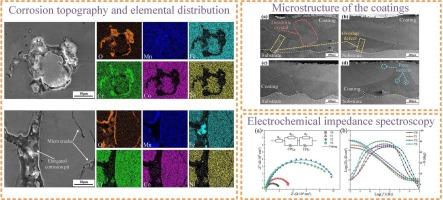温度场辅助激光熔覆 CrMnFeCoNi 高熵合金镀层的微观结构和腐蚀特性
IF 5.3
2区 材料科学
Q1 MATERIALS SCIENCE, COATINGS & FILMS
引用次数: 0
摘要
采用温度场辅助激光熔覆工艺在 Q345 钢表面制备了 CrMnFeCoNi 高熵合金镀层,研究了外加温度场对熔覆镀层的影响。观察了涂层的微观结构和腐蚀形貌,分析了不同涂层的元素分布、硬度、有效弹性模量、电化学腐蚀性能和腐蚀产物。结果表明,用温度场制备的 HEA 涂层的孔隙率降低到初始水平的 50% 以下。涂层的微观结构发生了变化,涂层的纳米压痕硬度增加了 0.55 GPa,提高了机械性能。在所有涂层中,250 °C 温度场下制备的涂层表现出最好的耐腐蚀性,腐蚀电位和电流密度分别为-0.27 V 和 0.15 μA/cm2,与室温下制备的样品相比,腐蚀电位提高了 0.1 V,电流密度降低了 1.08 μA/cm2。加入温度场后,涂层上的被动膜在腐蚀过程中的稳定性得到改善,点蚀成核率降低。因此,在激光熔覆过程中加入适当的温度场可有效提高铬锰铁钴镍 HEA 涂层的整体性能。本文章由计算机程序翻译,如有差异,请以英文原文为准。

Microstructure and corrosion properties of CrMnFeCoNi high entropy alloy coating by temperature field-assisted laser cladding
The CrMnFeCoNi high entropy alloy coatings were prepared on the surface of Q345 steel using a temperature field-assisted laser cladding process, and the effects of the applied temperature field on the cladding coatings were studied. The microstructures and corrosion morphologies of the coatings were observed, and the elemental distribution, hardness, effective elastic modulus, electrochemical corrosion performance, and corrosion products of different coatings were analyzed. The results show that the porosity of the HEA coatings prepared with a temperature field is reduced to below 50 % of the initial level. The microstructure of the coating changed, with the nanoindentation hardness of the coating increasing by up to 0.55 GPa, enhancing the mechanical properties. Among all the coatings, the coating prepared at 250 °C temperature field exhibited the best corrosion resistance, with corrosion potential and current density of −0.27 V and 0.15 μA/cm2, respectively, improving the corrosion potential by 0.1 V and reducing the current density by 1.08 μA/cm2 compared to the sample prepared at room temperature. After incorporating the temperature field, the stability of the passive film on the coating during corrosion improved, and the nucleation rate of pitting decreased. Therefore, incorporating an appropriate temperature field during laser cladding can effectively enhance the overall performance of the CrMnFeCoNi HEA coating.
求助全文
通过发布文献求助,成功后即可免费获取论文全文。
去求助
来源期刊

Surface & Coatings Technology
工程技术-材料科学:膜
CiteScore
10.00
自引率
11.10%
发文量
921
审稿时长
19 days
期刊介绍:
Surface and Coatings Technology is an international archival journal publishing scientific papers on significant developments in surface and interface engineering to modify and improve the surface properties of materials for protection in demanding contact conditions or aggressive environments, or for enhanced functional performance. Contributions range from original scientific articles concerned with fundamental and applied aspects of research or direct applications of metallic, inorganic, organic and composite coatings, to invited reviews of current technology in specific areas. Papers submitted to this journal are expected to be in line with the following aspects in processes, and properties/performance:
A. Processes: Physical and chemical vapour deposition techniques, thermal and plasma spraying, surface modification by directed energy techniques such as ion, electron and laser beams, thermo-chemical treatment, wet chemical and electrochemical processes such as plating, sol-gel coating, anodization, plasma electrolytic oxidation, etc., but excluding painting.
B. Properties/performance: friction performance, wear resistance (e.g., abrasion, erosion, fretting, etc), corrosion and oxidation resistance, thermal protection, diffusion resistance, hydrophilicity/hydrophobicity, and properties relevant to smart materials behaviour and enhanced multifunctional performance for environmental, energy and medical applications, but excluding device aspects.
 求助内容:
求助内容: 应助结果提醒方式:
应助结果提醒方式:


